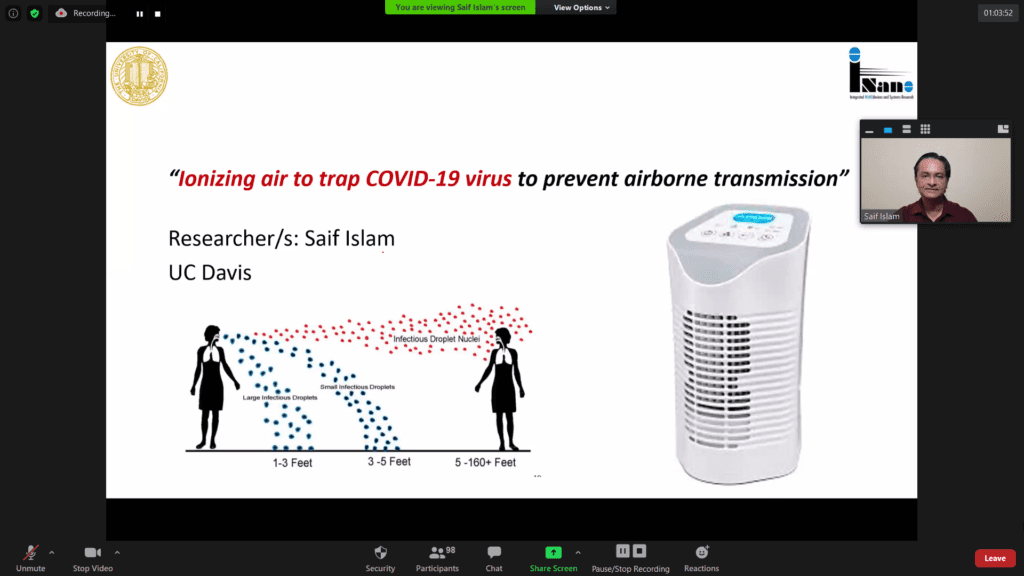
On 22 July 2020, IEEE BUET Student Branch organized a webinar through online platform Zoom as part of the Tech Talk webinar series which is based on the theme “Research and innovation challenges during COVID-19”. This was the third webinar of the series where IEEE IAS BUET Student Branch Chapter, IEEE SPS BUET Student Branch Chapter, IEEE RAS BUET Student Branch Chapter, IEEE EMBS BUET Student Branch Chapter, IEEE BUET Student Branch WIE Affinity Group, & IEEE Bangladesh Section were the co hosts for the event along with IEEE BUET Student Branch. The purpose of this webinar was to share the ideas of research facilities and opportunities in the field of science and engineering during the ongoing pandemic of COVID-19.
The webinar was initiated at 5.00 PM as Dr. Celia Shahnaz welcomed everyone and thanked the speaker for allocating time for the webinar amidst his busy schedule. Sanjana Mehjabin, Chair, IEEE BUET SB WIE Affinity Group, introduced the speaker Dr. M. Saif Islam by reading out his bio to familiarize everyone with his academic and professional background. Then the moderator requested the speaker to begin his talk.

In his presentation, Dr. Islam mainly focused on the overall research situation in California in the current lockdown. Firstly he showed the airborne transmission process of COVID-19 and the minimization processes which are being developed by the scientists, doctors, pharmacists of California and other people related to this field. He introduced a new form of architecture where we can use UV lamps, portable air cleaner, sensors, ventilators to block the virus from entering a room with air-conditioning and to design the air flow diagram for living spaces during COVID era. He talked about a new process where we can use a filter, like HEPA filter, and ionize the virus. But unfortunately, this process produces ozone which is dreadful for our lungs. So they are trying to avoid producing ozone by giving negative charged oxygen ions. Dr. Islam talked briefly about the solutions to COVID-19 proposed by The Center for Information Technology Research in the Interest of Society (CITRIS), the Banatao Institute and Tecnológico de Monterrey. The attendees learnt about different kinds of research going on to battle the hazards of COVID-19 like the multicampus infrastructure to advance telehealth implementation for low-income Californians in response to COVID-19 which is being researched by three professors from UC Berkeley, UC Merced and UC Davis and an AR video-assisted clinical care for remote management by two professors from UC Santa Cruz and UC Davis. They also got to know about the two professors from UC Berkeley who are working on identifying COVID-19 misinformation and Hayden Taylor from UC Berkeley who is doing research on delivering safer air in healthcare facilities.

After all this, Dr. Islam started to explain his research procedure in a detailed way which was focused on the safe ionization process to trap viruses like Influenza, Rota, SARS, COVID-19 and Calcivirus. He introduced a gas ionization device with flat metal electrodes which can trap viruses like COVID – 19, which have an average length of 100 nm. But use of flat metal electrodes results in the use of high voltage which can be dangerous for the patients as it produces ozone. He then explained the alternative method of field ionization with sharp metal tips and Carbon nanotubes which lowers the voltage level preventing the creation of ozone. He showed the mathematical formulas using the basic theory.
At the concluding stage, Dr. Celia thanked Dr. Islam for sharing his wonderful and sustainable research ideas and requested the participants to ask their questions to Dr. Islam. So there was a short Q&A segment and Dr. Islam was kind enough to answer all the questions of the keen participants. Everyone praised highly of the informative session and expressed their gratitude towards the speaker. After the session ended, Satyaki Banik, Chair of IEEE BUET SB, took a screenshot of the group view of the participants on Zoom which was considered as a group photo. He also provided a feedback form to the participants and thus the wonderful webinar came to an end.